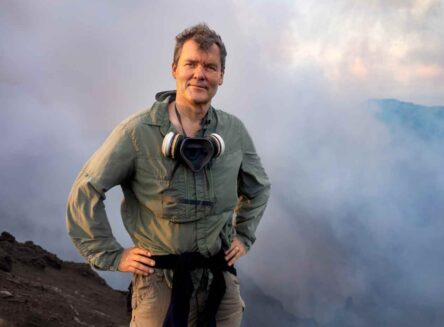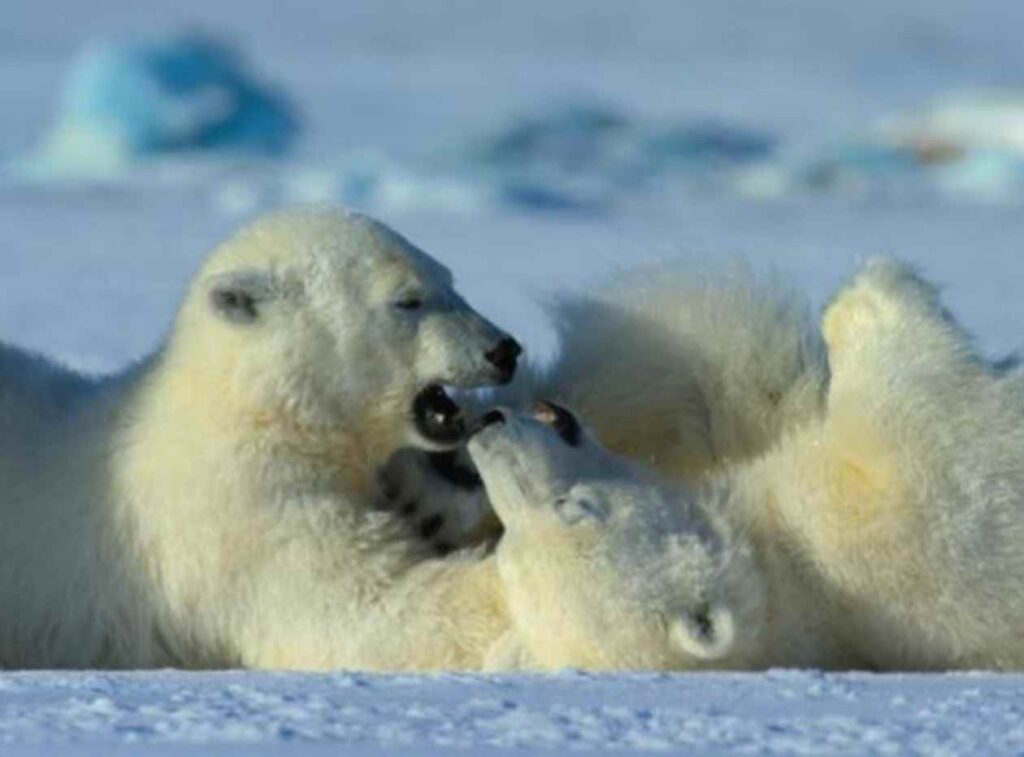
Netflix’s ‘Our Planet’ Producer to Offer Behind-the-scenes Stories from Some of the World’s Wildest Places
In the view of Huw Cordey, the clouded leopard is an amazing animal. It’s in possession of the largest canine teeth relative to its body size of any wild cat in the world. It lives both in the trees and on the ground, and it hunts monkeys for food. It can be found from Nepal, Bangladesh and Assam through Indochina, to Sumatra and Borneo, and northeast toward southern China. Some researchers believe the species diverged over 6 million years ago, thus making it one of the oldest feline species in the world.
But the clouded leopard is not an easy animal to find, much less catch on film. Still, for a little over two years, Cordey and a team, collaborating with an Oxford University scientist, tried to do just that. It’s Cordey’s job, after all.
For the last 30 years he has been making wildlife documentary films, with an emphasis on what he termed “blue chip” natural history series. That includes the likes of “Planet Earth,” “Sir David Attenborough’s Life of Mammals,” “Land of the Tiger,” “Big Cat Diary,” “Wildlife on One,” “Andes to Amazon,” and more recently, Netflix’s “Our Planet.”
On April 6, Cordey will be presenting at the Wachholz College Center on his work, offering a behind-the-scenes look at the lengths that he and other wildlife filmmakers and documentarians go in order to capture animals and environments in some of the most difficult-to-access parts of the world. The event is called “The Making of Our Planet, Frozen Worlds with Huw Cordey.” Cordey described it as a wide-ranging talk focused broadly on his work on the “Our Planet” series, with some emphasis on the “Frozen Worlds” episode.
“Frozen worlds are some of the most challenging places of all, because obviously they’re remote,” Cordey said. “You’ve got extreme conditions, you’ve got, you know, rare animals, you know, dangerous animals, like polar bears. So it kind of sums up all the challenges of making a wildlife film.”
Among the aspects of “Frozen Worlds” Cordey plans on discussing is a scene in which walruses fall from a cliff and plunge to their death. The crew behind “Our Planet” attributed the deaths to crowding on the ice that walruses prefer to gather on. “This is the sad reality of climate change. They’d be on the ice right now if they could be,” Director Sophie Lanfear says during a behind the scenes video about the moment.
“That was an extraordinary scene brought on by extreme conditions — climate change — and they would never have done that normally” Cordey said.
Cordey’s first big break in the industry came with the 1994 release of an episode of BBC’s “Natural World” series focused on prairie dogs in the Badlands of South Dakota. As part of the field work for the episode, Cordey spent a year living in South Dakota. Beginning in 1995, he started working for the BBC’s Natural History Unit, where he remained for the next 14 years, until he left for Bristol, England-based Silverback Films in 2009. As an executive producer for Silverback Films, Cordey has worked on projects including Netflix’s “Our Planet” series, and his recent, forthcoming work includes a two-part series for Disney on bees, and a series for Netflix on the Arctic. Last summer, Netflix released a project he worked on as an executive producer called “Secret Lives of Orangutans,” which examines the life of a multigenerational Sumatran orangutan family, and was touted by Silverback Films as the world’s first feature-length film about wild orangutans.
The aforementioned story of the clouded leopard is a particularly illustrative one for Cordey, because it demonstrates the amount of effort that goes into just a single shot. And he says he could spend all day telling stories in a similar vein. For “Our Planet,” Cordey’s responsibilities included completing the “Jungles” episode. Over the years they spent trying to document the clouded leopard, there were some glimpses at night, but nothing of the quality needed. And then one day, a camera trap caught footage of a clouded leopard as it sauntered past a buttress tree in a Borneo jungle. The two-year wait produced a brief shot that was cut down to seven seconds, which appear within the first roughly 2 minutes and 10 seconds of the “Our Planet: Jungles” episode.
Each time such a wildlife series or documentary is released, Cordey sees it as sort of raising the bar for what’s going to be done next. People’s expectations are high, and in order to continue to deliver them the sense of wonder and amazement that is so often associated with these types of wildlife series, that means trying to continue to challenge oneself with difficult undertakings. At the same time, platforms like YouTube have created more competition for people’s attention, and Cordey now sees AI as starting to cast an influence on what people may come to expect out of nature.
“AI is creating these ridiculous — funny, maybe — but ridiculous behaviors of animals that don’t exist. So people can watch these things and say ‘Wow, does that lizard really dance like that?’” Cordey said, adding that he’s not sure if the authenticity of the work he does will continue to excite people in lieu of these types of media. “Time will tell,” he said.
For the time being though, the work continues to be received well, even if it has become harder in recent years than it used to be when it comes to getting the attention of the same number of people as quickly. And of course conservation, something that many of his projects implicitly or explicitly advocate for, can be a polarizing topic. Which means that attention needs to be paid to how stories are told.
“You can get people who believed in it, but just get fed up with being beaten over the head by it. You get people who may somehow deny it, like a conspiracy theory, like it doesn’t exist. Or you can get the people that just love it and can’t get enough of it. But you never want to be preaching to the converted on a natural history series. In a big series, you’re trying to gather in a big audience.”
Making judgment calls on when to give up on a shot, scene or subject, and when to keep pressing on, is a fundamental part of this particular facet of the media business in which the stars of the show aren’t exactly team players. As Cordey put it, “animals don’t read scripts.” Which is why he advocates that his associates tear up their shot lists at the airport and throw them in the trash. “To me, it’s a hopeless way of trying to make a wildlife film,” Cordey said. “You need to be going with the flow. And of course, it’s not to say … that you, you know, you just get on a plane and hope for the best.”
Months and months of research and preparation need to be done in advance, but then when Cordey and his crew are on the ground, it’s about keeping their eyes open, and being cognizant of the direction the story around them is moving in, whether they like it or not.
“My modus operandi is to get in the field, and sort of start and see where it’s going, and make the decision every day. It’s like, ‘Okay, that’s happened.’ Watch the footage right now. Let’s look out for this, and try to sort of tell those stories organically as they unfold.”
In order to produce the type of series he specializes in, Cordey says a minimum of three years is needed, but sometimes it can take longer. Twenty years ago when he was working on the first “Planet Earth,” the work took four-and-a-half years. Projects take so much time in large part because of the seasonal nature of what they seek to document. If they want to catch an animal at a seasonally-specific time, but fail to do so, the only way to have another chance is to wait until the next year when the season returns.
And of course the conditions on the ground can be extremely difficult. For “Secret Lives of Orangutans,” Cordey said every shot “was like chipping concrete.” Navigating the swampy Sumatran jungle meant carrying 30 kilos of camera equipment, which then had to be set up for shots that might quickly disappear if an orangutan shifted out of the picture amid the dense vegetation.
That particular project was able to utilize drone technology to tell the story of these primates in a groundbreaking way. The animals spend most of their life in the treetops, but it was only in recent years that drone technology advanced to the point where it was feasible to try and document them at that level without actually climbing up into the trees with cameras. Using lightweight drones with extended battery life, Cordey’s crew was able to habituate the orangutans to the presence of the drones, resulting in treetop footage that he believes provides an insight and perspective on orangutans that had been almost impossible to capture before.
The goal with his work, he said, is to tell entertaining stories where people really feel they learn about the natural world. “How animals adapt, how they work, you know, what their behavior means, but also what the dangers are to their lives, the issues surrounding a habitat and so on. So, I think that’s very, very important.”
“The Making of Our Planet, Frozen Worlds with Huw Cordey” is Sunday, April 6 at 7 p.m. at the Wachholz College Center at Flathead Valley Community College. For more information, including to purchase tickets, go to wachholzcollegecenter.org.
